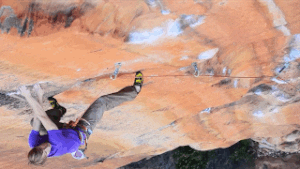OK, so I  back and forth if I even wanted to post the question, but hey why not.
back and forth if I even wanted to post the question, but hey why not.
It would seem to me that engraving a marking in an Anodized Aluminum carabiner used for climbing would be a bad idea.
Any evidence one way or another?
OK, so I  back and forth if I even wanted to post the question, but hey why not.
back and forth if I even wanted to post the question, but hey why not.
It would seem to me that engraving a marking in an Anodized Aluminum carabiner used for climbing would be a bad idea.
Any evidence one way or another?
I have engraved carabiners, but they were not going to be used for climbing. Are you thinking the engrave would weaken them in some way. I believe the engraving simply removes a bit of the surface coating. I don’t know if the integrity of the carabiner would be compromised any more than if it got scratched in use.

If a brush with a 40W CO2 laser impacts the integrity that much, could they be that good in the first place?
Even less than that: it’s just bleaching the dye in the anodization.
I do not know the specific treatment/chemistry of those, but it can get quite tricky. I had some aluminium specifically designed to make punches that were more durable than steel dies, but not much heating would turn it back to ordinary soft aluminium.
I would look up those specifics before trying.
Well done made me laugh out loud
This is along the lines of what I am wondering.
Interesting question. All be it I’m not as good of a climber as @Jules eludes to with her gif. I do entrust my life to these things. They are hardy when it comes to scratches and some drops and such. But I’m wondering if there is any known research to the results of lasering.
Current practice is do all I can to not mess up the thing my life hangs from. All other risk accepted.
Interesting. Do you have any research I could reference on this? I’ve not heard it put that way.
Interesting. Look what the googles found. Petzl is on of my fav climbing brands.
- It is possible to use an electric engraving pen (depth of less than 0.1 mm) to engrave the number on the frame, next to the serial number. Warning: stamp lettering (typewriter-like steel punch letters) is strictly forbidden, as is any machining of the product.
Seems like you have your own answer. Why mess with it?
Laser engraving is not structurally damaging to the carabiner, the process attacks the cosmetic coating, not the aluminum body. The reason that stamping and machining are not recommended is because those processes are structurally damaging. Stamping compresses the aluminum, changing the structural composition, and machining removes a small portion of the aluminum and does the same. The manufacturer has not performed any testing to determine the degree of structural change, there may well be none taking place, or so little that there is effectively no change to the structural integrity of the carabiner, therefore no change in its ability to perform the job for which it was made, but without testing these affects the manufacturer has no choice but to advise against them… liability being what it is.
I don’t climb with gear so I don’t know, but as a Fail-Safe lifeline I would put more faith in steel than aluminum.
The metallurgical qualities of most of the fancy Aluminums are set by other metals included, a very tight heating schedule, in an atmosphere of more specific chemistry. There is a lot of variation and some are more simple than others, but the notes made are for more than compression of the metal, but disturbing the house-of-cards that makes aluminum more structural than raw copper can revert all that effort.
An extreme example of modifying your kit to death: A parachutist had a hard time closing the container after folding the parachute and cords into the backpack. So, he installed velcro patches to use instead of the pins that got pulled out by the drogue 'chute.
Problem: Jumper didn’t use just one piece, but four or more. Velcro has more staying power than the wind-pulled drogue 'chute, even during freefall. Unfortunately, the wind kept the drogue out of the jumper’s reach so he could not manually pull the opening cord.
Reserve parachute deployed too late; jumper augured in.
[Drogue parachute is a ripcord replacement; it is a mini-chute that resides in a protected pocket on the straps of the backpack until it is pulled out. Jumper pulls it out and the drogue then pulls the pins holding the backpack closed, allowing the main to open w/out losing the ripcord.]
Has anyone ever suggested tying down the other end of the ripcord?
Typical rigcord is just long enough for jumper to grasp & pull the pins out. Make it longer, and jumper’s reach is not long enough; tie it to the backpack and a) it might not pull all the pins, being restricted and/or b) interfere w/the main parachute being deployed.
A jumper with a ripcord rig must hold onto it all the way to landing…the jump club made lots of $ off newbie jumpers forgetting to hold on & dropping it after the pull. The drogue 'chute is actually attached to the top of the parachute so it can never get involved in the opening sequence.
I’ve edited my earlier post, since I incorrectly stated the drogue was attached to the straps; it isn’t, it’s attached to the parachute.
Because If I can find definitive proof that it does not weaken the metal then It is a great way to mark my gear for identification and sorting.
This topic was automatically closed 32 days after the last reply. New replies are no longer allowed.